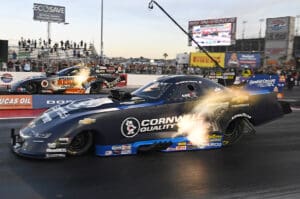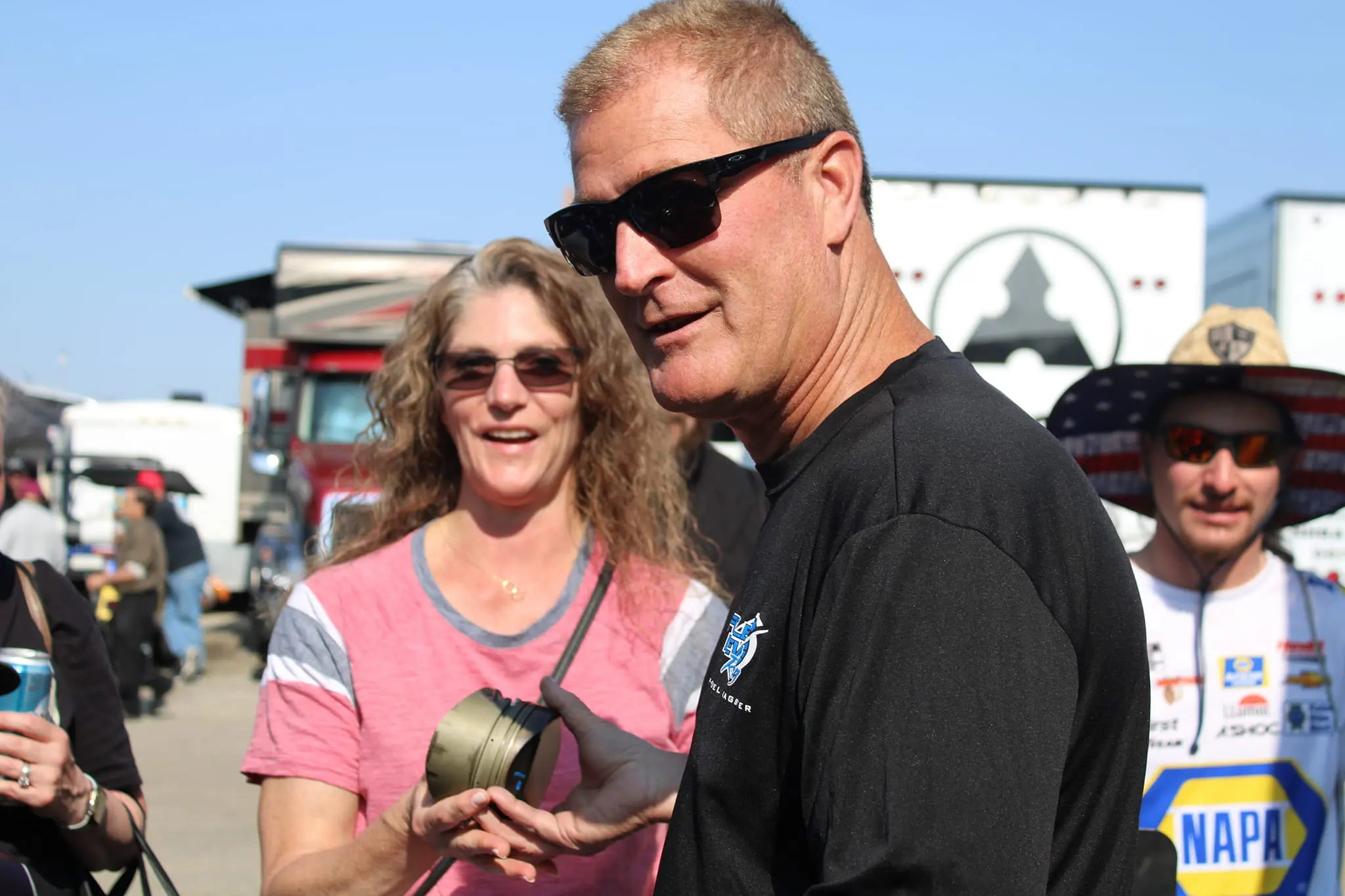When longtime Funny Car crew chief John Medlen retires to his mountain cabin near Ellijay, Ga., he will do so knowing he was able to go to bed at night satisfied that the drag-racing world has a heightened vigilance when it comes to safety.
“I feel comfortable,” Medlen said, quickly clarifying, “I’ll never give up on it. I’ll never say, ‘Oh, we got it.’” With a literal nod toward Ron Capps Motorsports’ NAPA Toyota Supra and a figurative nod to all the race cars in the Camping World and Lucas Oil drag racing series pits, he said, “These things will bite in a heartbeat if you say that.”
His son knew it. Eric Medlen followed the 2003 news story out of Las Vegas about Montecore, the white tiger that seriously injured Roy Horn of the famous Siegfried & Roy magic/entertainment extravaganza. And the young Funny Car driver dubbed his race car “Montecore.” And he said back then exactly the same thing his father did nearly 20 years later: “These things will bite you in a heartbeat.”
Montecore, the race car, took its cue from Montecore, the tiger. It bit Eric Medlen in March 2007 during a testing run at Gainesville, Fla. Medlen was unable to survive the effect of severe side-to-side head battering while experiencing an almost-unheard-of degree of tire shake. From his death four days after the accident grew a collaborative effort to improve roll cages, helmets, chassis tubing, and materials, as well as study concussions . . . a research- and results-oriented movement called The Eric Medlen Project. The name spreads across the John Force Racing headquarters at Brownsburg, Ind., in gigantic lettering – bigger-than-life like Eric Medlen, representing the big and bold, larger-than-life purpose of saving lives.
John Medlen, who was his son’s crew chief, is closing his career not at John Force Racing, not at Don Schumacher Racing, but at Ron Capps Motorsports. However, his mission to ensure Eric’s incident was not in vain knows no bounds and has no real conclusion.
“It’ll never end . . . when your heart’s in it and you know what can happen,” John Medlen said.
He said he can rest better, assured “that we’ve done pretty much everything humanly possible that we know of to protect the driver in his office,” Still, he also knows he might “wake up in the middle night, wondering about things,” because, he said, “that’s just the nature of the vision.”
He said he’s convinced the mission will continue: “There’s still that energy in the industry that they want to keep going, they want to have safety, we want to have the drivers come home at night. So I think that’ll be ongoing. Once you expose the potential aspects of this race car and what can happen, I think everybody’s more aware and so they’re more cognizant of it.”

Who is John Medlen’s Elisha?
“My cell phone,” he said. “Call me anytime day or night, because you can’t plug you into somebody else. You can take everything that you’ve experienced for 36 years and someone else would understand it. But if you don’t realize it and you don’t go through what really happened and it’s just words, it doesn’t impact you the same as it is if you experience it yourself. So the experience itself gives you the passion to try to wrestle. When you tell someone about it, they just can’t quite grasp the magnitude of what went on.”
He said Don Garlits is an example of someone who lived through what he set out to prevent. “Big Daddy” had a horrific accident that cost him part of his foot. Instead of retreating, Garlits tapped into his creativity and designed the rear-engine Top Fuel dragster that marked a revolutionary step in protecting drivers.
“There,” Medlen said, “was a guy that took something. He didn’t want to quit. He was going to go back home and fix it. And look at the cars we have today.”
Metaphorically speaking, Medlen said, “Sometimes from the big chunks you get a little fallout of little chunks. Right now, we’ve pretty much captured all the big chunks. So is there going to be maintenance to what we do? Sure. The crew chiefs today and the crews are becoming more and more trained in what they do, because we’re getting a larger cross-section of people that have been in the industry long enough to see, ‘I got to watch this’. So I think that the level of safety is going to continue to go up.
 “If something else fails, and Heaven help us,” he said, “I don’t think it’s going to, as the energy goes up, [study] how much stress is in the parts. And then you have to jump all over it. Right now, the cars are good.
“If something else fails, and Heaven help us,” he said, “I don’t think it’s going to, as the energy goes up, [study] how much stress is in the parts. And then you have to jump all over it. Right now, the cars are good.
“And as the energy in the car keeps going up, you’re going to see it’s going to point to, ‘Maybe we need to look at this or that.’ We used to get 80 runs on a rear end. Now we get 30. We got more load into all of these parts, so the energy level, the wear on the materials, goes up. So you’ve got to keep watching, keep raising the envelope. So you got to keep watching. ‘Is anything showing signs? We haven’t seen that yet.’ You got to keep watching,” he said.
“It still boils down to maintenance. When you got a car, whether it’s a dragster or Funny Car, you got to look at it. All these teams do the same thing. When you see a crack in a particular area, ‘Why’d that happen?’ And so you go to other people. These guys are real good about sharing safety information with everybody. No secrets – maybe on the tune-up,” Medlen said with a twinkle in his eye. “I think the level of that is way up here from where it used to be.”
He said, “The sanctioning body, everybody, has gone a long way from where it was even to the point of better focus on material in the chassis . . . just minor things that you wouldn’t consider made a major effect on the driver’s seat.
“We discovered a lot about in the chassis aspect,” Medlen said. “The rule requires an MS 6736 D mill spec. So everybody said, ‘OK. Well, that mill spec must be good.” But in Eric’s chassis failure, we found out that none of the tubing fit that. It did not fit the MS 6736 D mill spec because the spec is about this long material composition. And we discovered that that mill spec required us to pull two pieces of tube out of a 500-piece bundle. So my question was ‘What if that doesn’t pass?’ Then we keep pulling material until it does. So we took 100 pieces of material and maybe 11 met the spec, but they pulled it out of a bundle that met the 6736 D mill spec. So technically it was correct, but it wasn’t adequate for what we were doing at all.
“So now the manufacturers, we do it at Schumacher’s and most everybody qualifies every single piece of tubing that goes in these cars. The carbon layers and mechanical properties to the chemistry and that in the industry has gone way, way better than usual. And there again, we didn’t know that existed then. But then when you start having failures, you said, ‘Well, maybe there’s something wrong with that mill spec.’ The mechanical properties and the chemical composition was correct, except that the range of what was allowable and how you qualified the tube was not acceptable. So now we took basically the same chemistry and basically the same mechanical properties and wanted to make sure that every single tube that goes in that car meets up and rightly so. The last maybe 1,000 pieces of tubing that we got at Schumacher’s, I don’t think we rejected any, and we tested each end of every single piece of tubing.
“It insures, when you go to sleep at night, that car has the best quality materials you can possibly get. That’s what I’m talking about when I say that the diligence of the people who are involved now know more about the nuances of a failure. We didn’t know that then. So to keep going with that quest is one side of the page. The other side of the page is don’t forget how you got to them. Don’t forget about all these things that happened that exposed you to looking.”
Medlen kept circling back to passion –“the passion in this that drives you to win. It’s a passion to make the best parts. The passion drives you to try to succeed. You got to have a sufficient amount of funds to allow you to look at the future, to allow you to try more things, allow you to experiment to a degree, to do more and more research. The value of the price of the tubing by itself is one thing, but the chemical testing and then we have to qualify, adds another degree for the expense of the car. But you have to have that to ensure that the car is correct.”
And if John Medlen’s curious mind ever is to kick into low gear – if only for a little while, if only long enough to enjoy his view of the Blue Ridge Mountains – he needs to know the cars are correct.









































